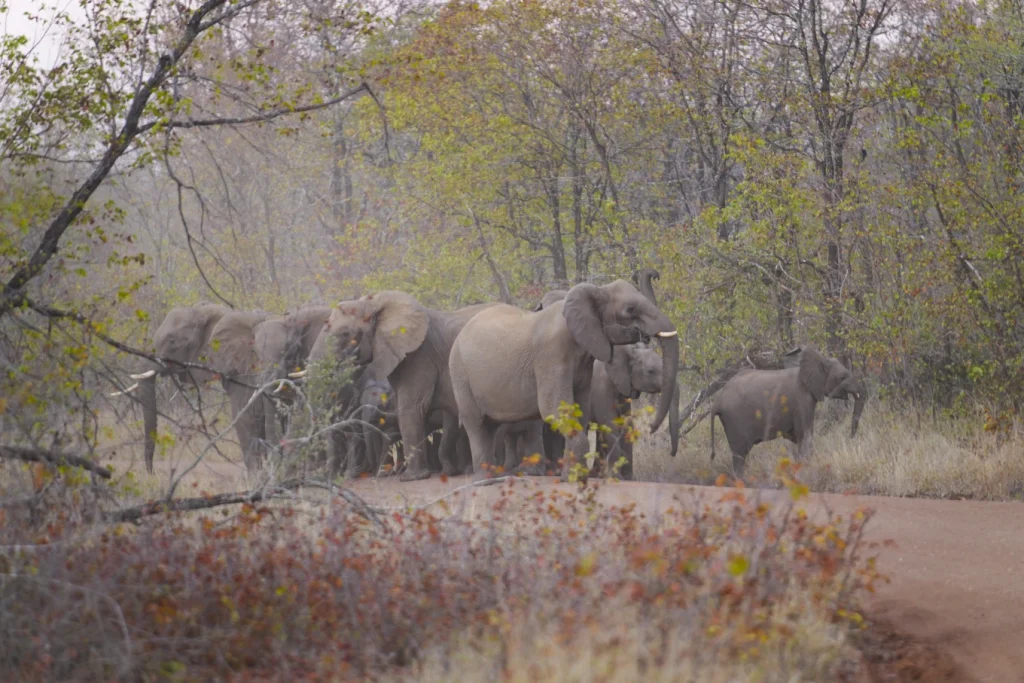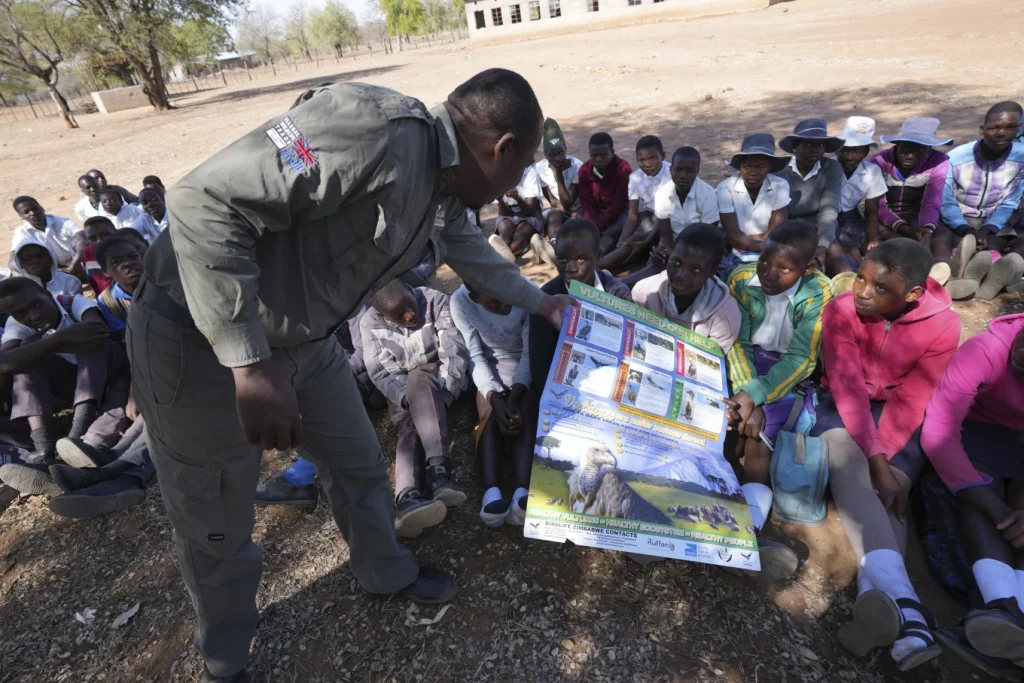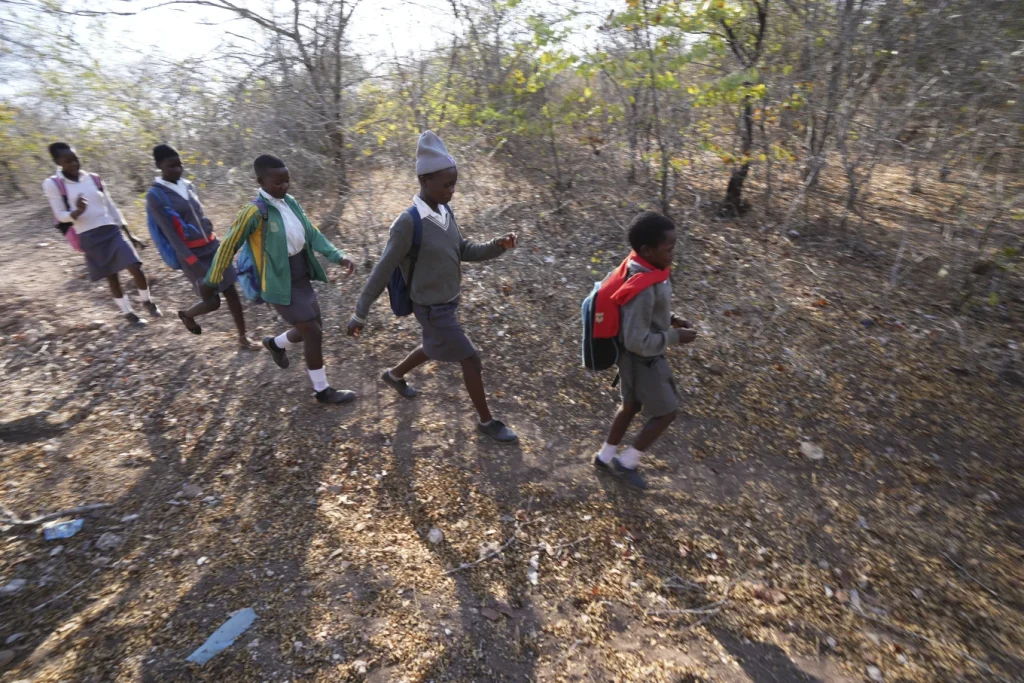The Save Valley Conservancy, situated in southeastern Zimbabwe, exemplifies a unique intersection of wildlife conservation and the daily realities faced by local communities.
In this region, where nature’s magnificence is starkly contrasted by human vulnerability, the stories of young children like 14-year-old Esther Bote bring to light the challenges and triumphs of living in close proximity to wildlife.
As these children navigate their perilous environment, they embody both the resilience required to survive and the potential for a future harmonized with wildlife.
Esther’s daily routine is emblematic of a childhood lived on the fringes of both human society and the vast wilderness. Each dawn, she engages in the mundane tasks of household maintenance — cleaning, cooking, and preparing for school.
Yet, unlike her peers in more secure environments, her journey to education is fraught with danger. Covering a distance of five kilometers through bush paths and forests, she and her peers are acutely aware of the wildlife that inhabits their surroundings.
With each step, they confront the anxiety of encountering dangerous species such as elephants and crocodiles, which have been known to roam perilously close to human habitats.
These hazardous paths are not merely a backdrop to their education but a constant reminder of the intricate balance that exists between human life and wildlife in this region.
The impact of environmental crises, exacerbated by climate change and recurring droughts, has compounded these challenges.
Local communities face severe food and water shortages, which further drives wildlife into closer proximity with human settlements, creating a tug-of-war over dwindling resources.
In this context, adapting to the realities of living alongside wildlife becomes a necessity for survival rather than a choice.
Children, from as young as five, learn not only to navigate the physical landscape but also to embrace an intrinsic understanding of the animal behavior that can either harm or help them.
In response to these challenges, the Save Valley Conservancy, in partnership with Zimbabwe’s national parks agency, has initiated educational programs aimed at empowering children and fostering coexistence with wildlife.
This innovative approach addresses the urgent need for strategies that allow children to identify and interpret embedded danger signs, thereby reducing risks associated with wildlife encounters.
The program equips students, like Esther, with essential skills such as recognizing animal footprints, interpreting various animal sounds, and understanding environmental cues. Through these lessons, they develop an essential toolkit for survival in their unique ecological landscape.
The importance of group dynamics is evident in Esther’s account; she explains how walking in groups enhances their safety.
This camaraderie not only facilitates a shared experience of navigating potential dangers but also fosters a sense of community and responsibility among the children.
Remarkably, they are not only learning about survival but are being taught to appreciate and respect the wildlife that exists around them — a fundamental shift in perspective that will shape their futures.
The program extends beyond mere survival tactics; it also aims to cultivate a sense of ownership and respect among the younger generation towards wildlife.
Dingani Masuku, the community liaison manager for Save Valley Conservancy, emphasizes the significance of targeting schoolchildren as a means of fostering this understanding.
By instilling in them the notion that wildlife can be allies rather than adversaries, the program seeks to create a culture of coexistence that enhances both human safety and wildlife conservation efforts. This shift in perception is crucial, as it aligns ecological stewardship with community well-being.
The educational sessions are impactful, as evidenced by a gathering of children in the open air for an instructional session on animal behavior.

Led by young women rangers from the community, the lesson underscores the practicalities of living in a wildlife-rich area. They educate the children on how to recognize predatory behavior and the necessity of avoiding confrontations with dangerous animals.
This proactive approach not only equips the youth with knowledge but also empowers them to take charge of their safety. Their ability to disseminate these lessons to their families stands as a testament to the program’s broader objectives.
The benefits of wildlife, particularly from a tourism perspective, are highlighted by officials from the national parks agency.
They illustrate how wildlife can serve as a source of employment and economic growth for communities. This assertion is crucial for altering perceptions, especially for parents who may traditionally view wildlife primarily as threats or sources of food.
By elucidating the positive aspects of wildlife, the initiative seeks to bridge the gap between local communities and conservation, presenting an alternative view that encompasses not only survival but also mutual enrichment.
As Esther and her peers continue to navigate their realities, they symbolize the nexus of hope and caution in a world characterized by complexity.
The Save Valley Conservancy’s efforts offer a glimmer of promise: a future where humans and wildlife can coexist harmoniously, informed by respect, awareness, and mutual benefit.
However, the long-term success of such initiatives will hinge on ongoing education, community engagement, and the recognition of wildlife as an integral component of their shared ecosystem.
The work being done to teach the next generation will determine not only their survival but the future of the wildlife they learn to honor.
In the face of adversity, young people like Esther emerge as leaders, advocates for coexistence, and preservers of a delicate ecological balance, striving to make their paths safer, not just for themselves, but for their communities as well.
The challenge posed by wildlife intrusion is multifaceted, one of which includes the psychological impacts on both students and teachers.
Obert Masaraure, president of the Amalgamated Rural Teachers Union of Zimbabwe, articulated a grim reality; students have withdrawn from school due to fear for their safety while the teachers themselves exhibit increasing absenteeism, primarily due to the threat that wild animals pose during their daily commutes.
This situation is further exacerbated by logistical constraints, as school authorities have had to manipulate school hours to accommodate the daylight activity of dangerous wildlife.
Such measures, although necessary, can inadvertently affect the quality of education provided, leading to longer-term negative implications on academic performance.
Despite the potential benefits of this initiative, it is essential to acknowledge the existing vulnerabilities faced by rural learners. The fear induced by wildlife interactions has resulted in observable psychological barriers, making learning environments less effective.
As highlighted by Esther, a student involved in the training program, the newly acquired knowledge about animals serves as a form of empowerment, albeit not a complete panacea for her fears.
This ambivalence underscores a critical point: while educational initiatives can significantly enhance understanding and safety to a certain degree, they do not erase the inherent threats posed by wildlife.
Statistics indicate a troubling trend: the Zimbabwe Parks Authority has logged an astounding increase in distress calls from communities grappling with wildlife confrontations, raising from about 900 calls in 2018 to between 3,000 and 4,000 in the last three years.
This alarming escalation serves as a stark reminder of the worsening conflict between human settlements and wildlife driven by climate change-related factors such as drought, which has precipitated wildlife encroachment into populated areas.
The urgency of these escalating circumstances calls for a robust and multi-faceted response strategy that includes education as one crucial component.
While it is clear that the education initiative has potential, its success hinges on a more comprehensive approach.
The creation of environmental clubs, the development of curricula that incorporate local ecological knowledge, and active participation from parents and community leaders are crucial elements for ensuring that wildlife awareness becomes integral to the community’s ethos.
Encouraging discussions at community forums where these issues can be debated and resolved collaboratively will be paramount. Only through a united front can communities articulate their needs and forge a path toward sustainable coexistence with wildlife.

In conclusion, the educational initiative advocating for wildlife awareness in Zimbabwe’s rural schools reflects a necessary step towards bridging the knowledge gap regarding human-wildlife interactions.
While hesitant parents are slowly shifting their attitudes, recognizing the value of training programs in safeguarding their children, the challenges posed by human-wildlife conflict remain formidable.
The initiatives put forth by the Zimbabwe National Parks and Wildlife Management Authority reflect an understanding that education can empower younger generations to advocate for their safety and that of their communities.
Nevertheless, it serves as a reminder that coexistence with wildlife requires not only knowledge but also concerted, community-driven efforts to address the broader structural vulnerabilities that impact rural education.
The road ahead is undoubtedly complex, yet the commitment to educating the youth provides a foundational platform upon which long-term solutions may be built.
